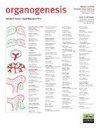去细胞化肝支架中多能干细胞或间充质干细胞的肝细胞分化:细胞- ecm粘附、空间分布和肝细胞成熟谱
IF 2.8
4区 生物学
Q4 BIOCHEMISTRY & MOLECULAR BIOLOGY
引用次数: 8
摘要
摘要间充质干细胞(MSC)和诱导多能干细胞(iPSC)已被报道能够在不同程度的肝细胞成熟的情况下在体外分化为肝细胞。印度尼西亚大学医学院组织学系在SCTE IMERI实验室建立了一种简单的肝支架脱细胞方法。15本研究旨在评估iPSC与脱细胞肝支架中衍生的MSC的肝细胞分化。研究阶段从iPSC培养、脱细胞、将细胞培养物植入支架并分化为肝细胞开始,持续21天。使用苏木精-伊红、Masson三色染色和免疫组织化学染色来表征支架中iPSC和MSCs的肝细胞分化,以确定分化区域的比例。在第7天和第21天分离RNA样品。使用qRT-PCR方法分析白蛋白、CYP450和CK-19基因的表达。用扫描电镜获得电镜图像,用HNF4-α和CEBPA标记进行免疫荧光检测。与脱细胞肝支架中的肝细胞分化的MSCs相比,本研究在肝细胞分化型iPSC中的结果显示出较低的粘附能力、单细胞形成和粘附量较低、白蛋白趋势降低以及CYP450表达较低。有几个因素促成了这一结果:较低的初始接种数量,这导致只有少数iPSC附着在脱细胞肝支架的某些部分,以及手动注射器注射用于再细胞化,这突然而不均匀地在支架中由肝细胞分化的iPSC形成单细胞模式。肝细胞分化的MSCs对胶原纤维脱细胞肝支架具有较高的粘附能力。这导致了积极的结果:白蛋白的增加趋势和CYP450的更高表达。肝细胞成熟表现为CK-19减少,这在脱细胞肝支架中肝细胞分化的iPSC中更为突出。HNF4-a和CEBPA证实在脱细胞肝支架成熟中成熟的肝细胞分化的iPSC是阳性的。本研究的结论是,与脱细胞肝支架中的肝细胞分化的MSCs相比,脱细胞肝框架中的肝细胞核分化的iPSC是成熟的,具有更低的细胞-ECM粘附力、空间细胞分布、白蛋白和CYP450表达。本文章由计算机程序翻译,如有差异,请以英文原文为准。
Hepatocyte Differentiation from iPSCs or MSCs in Decellularized Liver Scaffold: Cell–ECM Adhesion, Spatial Distribution, and Hepatocyte Maturation Profile
ABSTRACT Mesenchymal stem cells (MSC) and induced pluripotent stem cells (iPSC) have been reported to be able to differentiate to hepatocyte in vitro with varying degree of hepatocyte maturation. A simple method to decellularize liver scaffold has been established by the Department of Histology, Faculty of Medicine, Universitas Indonesia, in SCTE IMERI lab.15 This study aims to evaluate hepatocyte differentiation from iPSCs compared to MSCs derived in our decellularized liver scaffold. The research stages started with iPSC culture, decellularization, seeding cell culture into the scaffold, and differentiation into hepatocytes for 21 days. Hepatocyte differentiation from iPSCs and MSCs in the scaffolds was characterized using hematoxylin–eosin, Masson Trichrome, and immunohistochemistry staining to determine the fraction of the differentiation area. RNA samples were isolated on days 7 and 21. Expression of albumin, CYP450, and CK-19 genes were analyzed using the qRT-PCR method. Electron microscopy images were obtained by SEM. Immunofluorescence examination was done using HNF4-α and CEBPA markers. The results of this study in hepatocyte-differentiated iPSCs compared with hepatocyte-differentiated MSCs in decellularized liver scaffold showed lower adhesion capacity, single-cell-formation and adhered less abundant, decreased trends of albumin, and lower CYP450 expression. Several factors contribute to this result: lower initial seeding number, which causes only a few iPSCs to attach to certain parts of decellularized liver scaffold, and manual syringe injection for recellularization, which abruptly and unevenly creates pattern of single-cell-formation by hepatocyte-differentiated iPSC in the scaffold. Hepatocyte-differentiated MSCs have the advantage of higher adhesion capacity to collagen fiber decellularized liver scaffold. This leads to positive result: increase trends of albumin and higher CYP450 expression. Hepatocyte maturation is shown by diminishing CK-19, which is more prominent in hepatocyte-differentiated iPSCs in decellularized liver scaffold. Confirmation of mature hepatocyte-differentiated iPSCs in decellularized liver scaffold maturation is positive for HNF4-a and CEBPA. The conclusion of this study is hepatocyte-differentiated iPSCs in decellularized liver scaffold is mature with lower cell–ECM adhesion, spatial cell distribution, albumin, and CYP450 expression than hepatocyte-differentiated MSCs in decellularized liver scaffold.
求助全文
通过发布文献求助,成功后即可免费获取论文全文。
去求助
来源期刊

Organogenesis
BIOCHEMISTRY & MOLECULAR BIOLOGY-DEVELOPMENTAL BIOLOGY
CiteScore
4.10
自引率
4.30%
发文量
6
审稿时长
>12 weeks
期刊介绍:
Organogenesis is a peer-reviewed journal, available in print and online, that publishes significant advances on all aspects of organ development. The journal covers organogenesis in all multi-cellular organisms and also includes research into tissue engineering, artificial organs and organ substitutes.
The overriding criteria for publication in Organogenesis are originality, scientific merit and general interest. The audience of the journal consists primarily of researchers and advanced students of anatomy, developmental biology and tissue engineering.
The emphasis of the journal is on experimental papers (full-length and brief communications), but it will also publish reviews, hypotheses and commentaries. The Editors encourage the submission of addenda, which are essentially auto-commentaries on significant research recently published elsewhere with additional insights, new interpretations or speculations on a relevant topic. If you have interesting data or an original hypothesis about organ development or artificial organs, please send a pre-submission inquiry to the Editor-in-Chief. You will normally receive a reply within days. All manuscripts will be subjected to peer review, and accepted manuscripts will be posted to the electronic site of the journal immediately and will appear in print at the earliest opportunity thereafter.
 求助内容:
求助内容: 应助结果提醒方式:
应助结果提醒方式:


